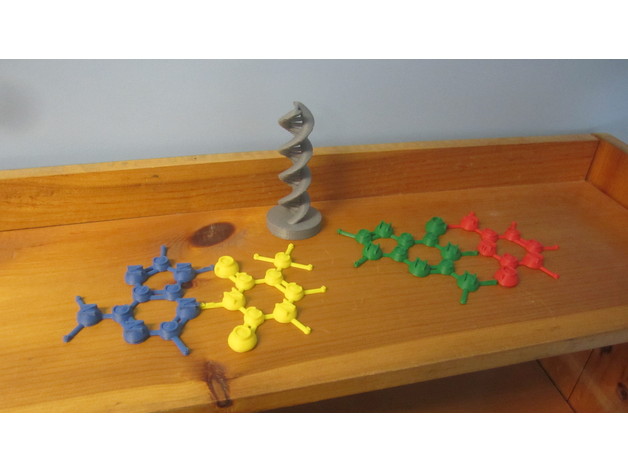
DNA Helix and Nucleotides
thingiverse
The intended use of our model is to provide a closer visual look at DNA and the structure within the Helix and Nucleotides. With this, we intend to demonstrate the mathematical concepts behind the structures as well as there shapes and areas. Also, the aspect of using different scaling processes to accurately represent each atom and bond to demonstrate different components of size in comparison to one another. Also with DNA, there are many ways which you can alter and manipulate chromosomes as well as bonds to create a mutation. With this, we intend to get at the probability aspect of how you can create infinitely many mutations based on mixing up bonds as well as changing different pair of chromosomes, splicing and so forth. With this model, we intend to bring in a real life example, such as scientific DNA, and explain how the principles and structure of it relate to the field of Mathematics. For sources we used various Google images to inspire our design process in producing the four different nucleotide structure. Print Settings Printer Brand: SeeMeCNC Printer: Rostock MAX Notes: The models in the photos were scaled up prior to printing: the helix was scaled by 500% and the nucleotides were scaled by 250%. All were printed with a 0.5mm diameter nozzle. Post-Printing Assembling Instructions For this model, there is not much to do for assembling. The main thing is that for the four Nucleotides, the ones that are paired together are that Adenine bonds with Thymine, and cytosine bonds with guanine. The bonding sites are marked with "I", "II", and "III". How I Designed This With this project, came a lot of work as well as a lot of time spent on perfecting it. For the Helix, we made a wide cylindrical base, to use as support for the helix model to be based on. We stretched the helix to spiral around 4-5 times. With the helix, we then connected 23 lines using the polar-caps cylinders to represent each pair of chromosomes. We were sure to cap each end of the line to give it that cylindrical shape and structure, all the same length and distance apart up the helix. For the nucleotide's, we produced four different types: Adenine, Thymine, Guanine, and Cytosine. For these, they each have different structures, yet are very similar. Used Hexagons inscribed in circles to get shape design. The Cylinders are used to represent the bonds between the different atoms. The Radii of cylinders went from (.25,->.4,->.8) by the time we were ready for our final print. The Spheres are used to represent the specific atom, and each sphere’s size is representative of the number of protons in the nucleus (ignoring neutrons). Also, on the atom we engraved the Atomic symbol for that element on top of the sphere to show which element it represents. Used interior angles to make pentagons, and scaled up the different elements to help with the printing. By the end of it all, we ended up making the nucleotides more compact and thicker for printing purposes We ended up slicing the model in half, that way we could have the spheres be flat to the print bed in order for it to print out effectively. Mathematical Problems and Questions. Mathematical Questions and Problems Some challenges and problems that occurred during our design process was having little details show up on our first print jobs. Also the scaling process, with being accurate and precise with each atom. We had difficulties with Rhino, sometimes not cooperating the way we would like. Also, Finding the bonding sites of where the atoms bonded and making sure it is accurate. The Organization/Calculation of different sizes and angle measurements was difficult in order to make the nucleotide's functionally printable. Some mathematical questions that came about during the design process was concerned with the 23 pairs of chromosomes and their area. Also, the similar lengths and area of cross sections as well as space between them, as well as angle similarities between the bonds and atoms. Signature: Ryan, Matt,
With this file you will be able to print DNA Helix and Nucleotides with your 3D printer. Click on the button and save the file on your computer to work, edit or customize your design. You can also find more 3D designs for printers on DNA Helix and Nucleotides.
